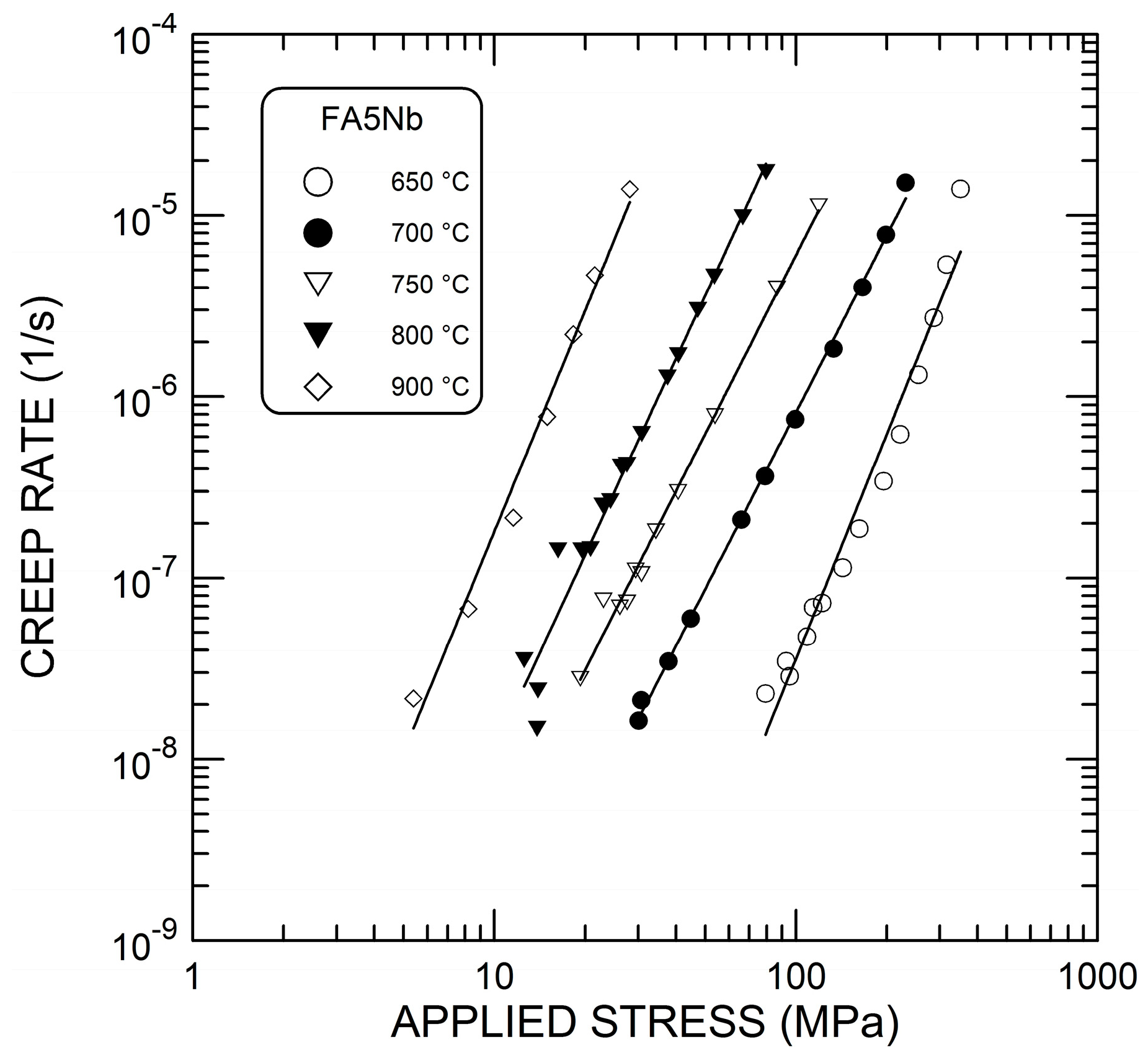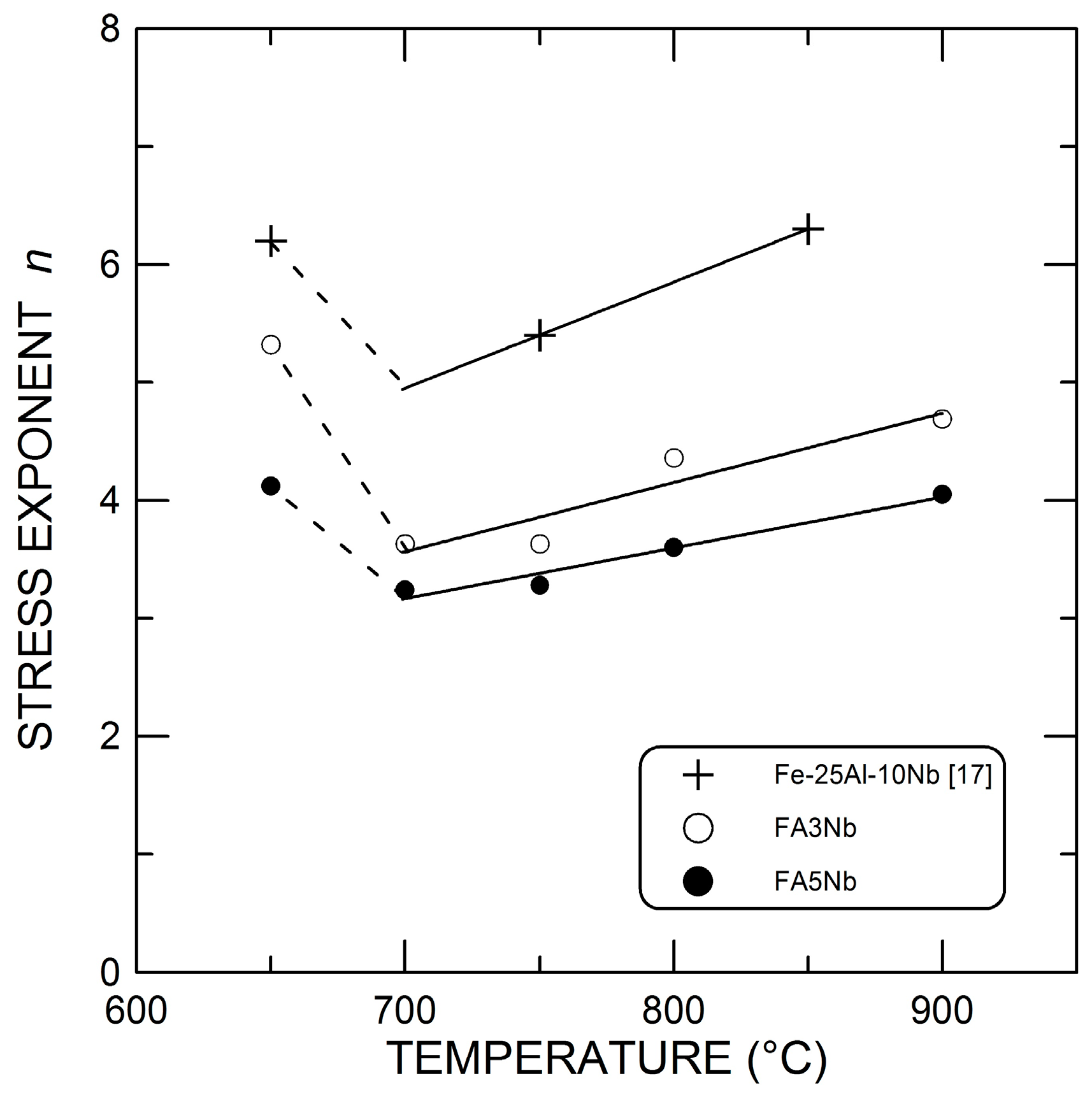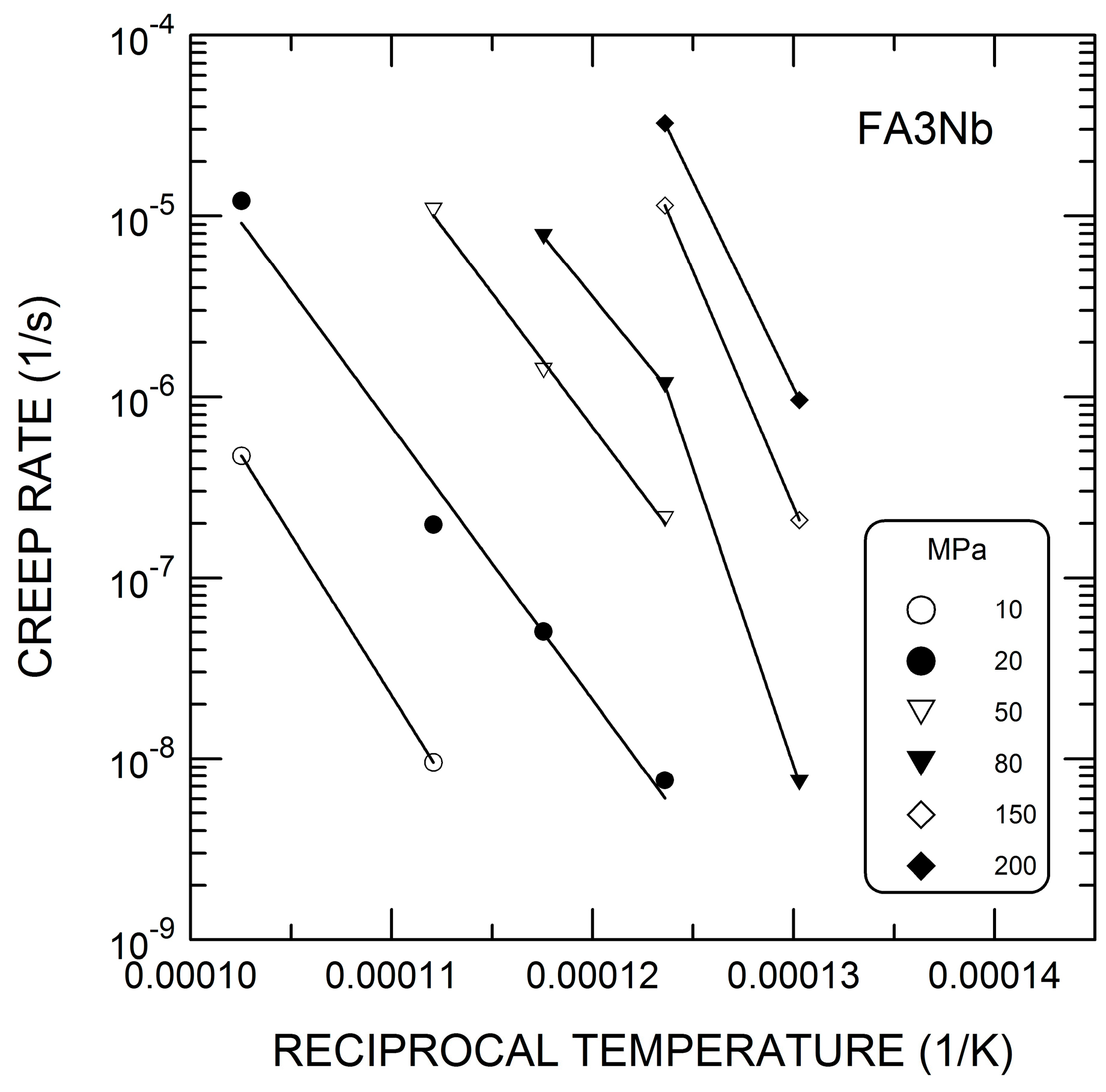The Influence of Niobium Additions on Creep Resistance of Fe-27 at. % Al Alloys
Abstract
:1. Introduction
2. Materials and Methods
3. Results
4. Discussion
- (i)
- At higher temperatures and lower stresses, the creep resistance of the 10% niobium alloy is higher than that of the lower niobium alloys. At a temperature of 850 °C, the creep resistance of the alloy with 10% of niobium is the best over the entire stress range studied.
- (ii)
- This effect is reversed at lower temperatures and higher stresses. At a temperature of 650 °C and stresses higher than 200 MPa, the 5% niobium alloy has the highest creep resistance.
5. Conclusions
- The studied range of temperatures could be divided into two areas: below and above 700 °C. This division follows the existence of different crystal lattices at lower and higher temperatures.
- The stress exponent n decreases with increasing temperature at temperatures up to 700 °C and increases at higher temperatures.
- The apparent activation energy of the creep is close to 335 kJ/mol and is comparable to the activation enthalpy of niobium diffusion in Fe(Al).
- At higher temperatures and lower stresses, the creep resistance of both alloys is worse than that of a 10% niobium eutectic alloy.
- At a temperature of 650 °C and stresses higher than 200 MPa, the 5% niobium alloy has the best creep resistance.
Author Contributions
Funding
Acknowledgments
Conflicts of Interest
References
- Sauthoff, G. Intermetallics; VCH Verlagsgesellschaft: Weinheim, Germany, 1995; pp. 84–89. [Google Scholar]
- Stoloff, N.S. Iron aluminides: Present status and future prospects. Mater. Sci. Eng. A 1998, 258, 1–14. [Google Scholar] [CrossRef]
- Liu, C.T.; George, E.P.; Maziasz, P.J.; Schneibel, J.H. Recent advances in B2 iron aluminide alloys: Deformation, fracture and alloy design. Mater. Sci. Eng. A 1998, 258, 84–98. [Google Scholar] [CrossRef]
- Palm, M. Concepts derived from phase diagram studies for the strengthening of Fe–Al-based alloys. Intermetallics 2005, 13, 1286–1295. [Google Scholar] [CrossRef]
- Morris, D.G.; Muñoz-Morris, M.A. Development of creep-resistant iron aluminides. Mater. Sci. Eng. A 2007, 462, 45–52. [Google Scholar] [CrossRef]
- Baligidad, R.G. Effect of niobium on microstructure and mechanical properties of hot-rolled Fe-8.5 wt% Al-0.1 wt% C alloy. J. Mater. Sci. 2004, 39, 5599–5602. [Google Scholar] [CrossRef]
- Baligidad, R.G. Effect of niobium on microstructure and mechanical properties of high carbon Fe–10.5 wt.% Al alloys. Mater. Sci. Eng. A 2004, 368, 131–138. [Google Scholar] [CrossRef]
- Morris, D.G.; Muñoz-Morris, M.A.; Requejo, L.M.; Baudin, C. Strengthening at high temperatures by precipitates in Fe-Al-Nb alloys. Intermetallics 2006, 14, 1204–1207. [Google Scholar] [CrossRef]
- Morris, D.G.; Requejo, L.M.; Muñoz-Morris, M.A. Age hardening in some Fe-Al-Nb alloys. Scripta Mater. 2006, 54, 393–397. [Google Scholar] [CrossRef]
- Morris, D.G.; Muñoz-Morris, M.A. Room and high temperature deformation behaviour of a forged Fe–15Al–5Nb alloy with a reinforcing dispersion of equiaxed Laves phase particles. Mater. Sci. Eng. A 2012, 552, 134–144. [Google Scholar] [CrossRef]
- McKamey, C.G.; Maziasz, P.J.; Jones, J.W. Effect of addition of molybdenum or niobium on creep-rupture properties of Fe3Al. J. Mater. Res. 1992, 7, 2089–2106. [Google Scholar] [CrossRef]
- McKamey, C.G.; Maziasz, P.J.; Goodwin, G.M.; Zacharia, T. Effects of alloying additions on the microstructures, mechanical properties and weldability of Fe3Al-based alloys. Mater. Sci. Eng. A 1994, 174, 59–70. [Google Scholar] [CrossRef]
- Zhang, Z.H.; Sun, Y.S.; Guo, J. Effect of niobium addition on the mechanical properties of Fe3Al-based alloys. Scripta Metall. Mater. 1995, 33, 2013–2017. [Google Scholar]
- Yu, Y.Q.; Sun, Y.S. Improvement of creep resistance of Fe3Al based alloys with tungsten and niobium additions. J. Mater. Sci. Lett. 2001, 20, 1221–1223. [Google Scholar]
- Morris, D.G.; Muñoz-Morris, M.A.; Baudin, C. The high-temperature strength of some Fe3Al alloys. Acta Mater. 2004, 52, 2827–2836. [Google Scholar] [CrossRef]
- Falat, L.; Schneider, A.; Sauthoff, G.; Frommeyer, G. Mechanical properties of Fe–Al–M–C (M = Ti, V, Nb, Ta) alloys with strengthening carbides and Laves phase. Intermetallics 2005, 13, 1256–1262. [Google Scholar] [CrossRef]
- Milenkovic, S.; Palm, M. Microstructure and mechanical properties of directionally solidified Fe–Al–Nb eutectic. Intermetallics 2008, 16, 1212–1218. [Google Scholar] [CrossRef]
- Yildirim, M.; Vedat Akdeniz, M.; Mekhrabov, A.O. Microstructural evolution and room-temperature mechanical properties of as-cast and heat-treated Fe50Al50-nNbn alloys (n = 1, 3, 5, 7, and 9 at%). Mater. Sci. Eng. A 2016, 664, 17–25. [Google Scholar] [CrossRef]
- Dobeš, F.; Kratochvíl, P.; Pešička, J.; Vodičková, V. Microstructure and creep behavior of Fe-27Al-1Nb alloys with added carbon. Metal. Mater. Trans. A 2015, 46, 1580–1587. [Google Scholar] [CrossRef]
- Palm, M. Phase equilibria in the Fe corner of the Fe–Al–Nb system between 800 and 1150 °C. J. Alloys Compd. 2009, 475, 173–177. [Google Scholar] [CrossRef]
- Kratochvíl, P.; Švec, M.; Král, R.; Veselý, J.; Lukáč, P.; Vlasák, T. The effect of Nb addition on the microstructure and the high-temperature strength of Fe3Al aluminide. Metal. Mater. Trans. A 2018, 49, 1598–1603. [Google Scholar] [CrossRef]
- Bonora, N.; Esposito, L. Mechanism based creep model incorporating damage. J. Eng. Mater. Technol. 2010, 132, 021013. [Google Scholar] [CrossRef]
- Esposito, L.; Bonora, N.; De Vita, G. Creep modelling of 316H stainless steel over a wide range of stress. Procedia Structural Integrity 2016, 2, 927–933. [Google Scholar] [CrossRef] [Green Version]
- Morris, D.G.; Muñoz-Morris, M.A.; Requejo, L.M. New iron–aluminium alloy with thermally stable coherent intermetallic nanoprecipitates for enhanced high-temperature creep strength. Acta Mater. 2006, 54, 2335–2341. [Google Scholar] [CrossRef]










| Alloy | Fe | Al | Nb |
|---|---|---|---|
| FA3Nb | 71.5 | 25.8 | 2.7 |
| FA5Nb | 67.9 | 27.3 | 4.8 |
© 2019 by the authors. Licensee MDPI, Basel, Switzerland. This article is an open access article distributed under the terms and conditions of the Creative Commons Attribution (CC BY) license (http://creativecommons.org/licenses/by/4.0/).
Share and Cite
Dobeš, F.; Dymáček, P.; Friák, M. The Influence of Niobium Additions on Creep Resistance of Fe-27 at. % Al Alloys. Metals 2019, 9, 739. https://doi.org/10.3390/met9070739
Dobeš F, Dymáček P, Friák M. The Influence of Niobium Additions on Creep Resistance of Fe-27 at. % Al Alloys. Metals. 2019; 9(7):739. https://doi.org/10.3390/met9070739
Chicago/Turabian StyleDobeš, Ferdinand, Petr Dymáček, and Martin Friák. 2019. "The Influence of Niobium Additions on Creep Resistance of Fe-27 at. % Al Alloys" Metals 9, no. 7: 739. https://doi.org/10.3390/met9070739





